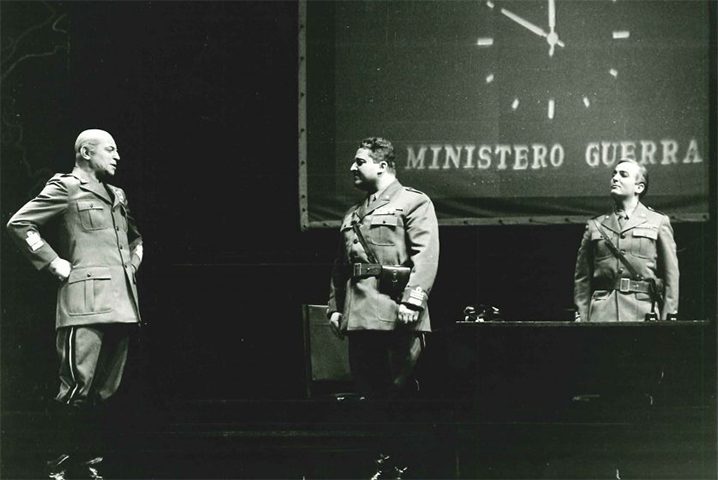Debutto: Genova, Politeama Genovese, 13 marzo 1971 (filmato RaiTeche)
| Regia | Luigi Squarzina |
| Regista assistente | Gianni Fenzi |
| Scene e costumi | Gianfranco Padovani |
| Produzione | Teatro Stabile di Genova |
Personaggi e interpreti
QUELLI DEL PERCHÉ
| Raffaele Persichetti | Giancarlo Zanetti |
| Operaio | Antonello Pischedda |
| Soldato | Davide Maria Avecone |
| Ufficiale | Pierangelo Tomassetti |
| Il generale di oggi | Maggiorino Porta |
I TESTIMONI
| La donnina/Mariella Lotti | Carla Bolelli |
| Ettore Muti, ex segretario del T.N.F. | Pietro Biondi |
| Eugenio Dollmann, colonnello delle S.S. | Gianni Fenzi |
| Ambasciatore Rudolph Rahn | Attilio Cucari |
| Frau Abeba | Anna Menichetti |
| Antonio Pennestri | Adolfo Fenoglio |
| Tenente Alberto Faiola, dei carabinieri | Tullio Solenghi |
LA CORTE
| Vittorio Emanuele III, re d’Italia e d’Albania e imperatore d’Etiopia | Daniele Chiapparino |
| Elena, sua moglie, la regina | Enza Giovine |
| Umberto, loro figlio, principe ereditario | Gianpiero Bianchi |
| Duca Pietro Acquarone, ministro della Real Casa | Alvise Battain |
| Generale Paolo Puntoni, aiutante di campo di Sua Maestà | Claudio Sora |
| Rosa Gallotti, cameriera | Mara Baronti |
I MINISTRI
| Pietro Badoglio, maresciallo d’Italia, capo del Governo | Gianni Galavotti |
| Raffaele Guariglia, ministro degli esteri | Piero Gerlini |
| Generale Antonio Sorice, ministro della guerra | Claudio Sora |
| Ammiraglio Raffaele De Courten, ministro della marina | Sandro Dal Buono |
| Generale Renato Sandalli, ministro dell’Aeronautica | Luigi Carubbi |
I POLITICI
| Dino Grandi | Rodolfo Traversa |
| Avvocato Mario Zamboni | Piero Gerlini |
| Ivanhoe Bonomi | Claudio D’Amelio |
| Segretario di Leg. Mario Badoglio, figlio del maresciallo | Giorgio Lopez |
L’ARISTOCRAZIA
| Duchessa Antonia Caetani d’Aragona, di Bovino | Anna Menichetti |
| Duca Gaetano Cafiero, di Bovino, suo marito | Luigi Carubbi |
| Ernesta Falcone, governante | Myria Selva |
| Il cuoco Alfonso | Enrico Ardizzone |
I MILITARI
| Generale Vittorio Ambrosio, capo del Comando Supremo | Camillo Milli |
| Generale Giacomo Carboni, capo del S.I.M. | Omero Antonutti |
| Generale Mario Roatta, capo di S.M. dell’Esercito | Adolfo Fenoglio |
| Maresciallo d’Italia, Enrico Caviglia, a riposo | Guido Lazzarini |
| Generale Calvi di Bergolo | Pietro Biondi |
| Colonnello Leandro Giaccone | Sandro Dal Buono |
| Il Generale Giuseppe De Stefanis | Claudio D’Amelio |
| Tenente Colonnello Iannuzzi, addetto di Ambrosio | Antonio Maronese |
| Colonnello Giorgio Salvi | Nino Faillaci |
| Generale Umberto Utili | Rodolfo Traversa |
| Colonnello Vincenzo Toschi | Attilio Cucari |
| Un sottufficiale | Mario De Martini |
| Un centralinista | Giorgio Lopez |
| Un piantone | Mario Marchi |
| Un attendente | Franco Griggi |
I CARABINIERI
| Generale Angelo Cerica | Maggiorino Porta |
| Maresciallo Vincenzo Agostinone | Sebastiano Tringali |
| Primo appuntato | Mario De Martini |
| Secondo appuntato | Mario Marchi |
LA POLIZIA
| Dottor Carmine Senise | Enrico Ardizzone |
GLI ANGLO-AMERICANI
| Generale Bedell Smith | Attilio Cucari |
| Generale Maxwell Taylor | Rodolfo Traversa |
| Colonnello William Tudor Gardiner | Antonio Maronese |
| Maresciallo Harold Rubert Alexander | Pietro Biondi |
| Generale Dwight Eisenhower | Guido Lazzarini |
| Harold Mac Millan | Franco Griggi |
| Roberto Murphy | Nino Faillaci |
LA MISSIONE ITALIANA
| Generale Giuseppe Castellano | Eros Pagni |
| Console Franco Montanari | Gianpiero Bianchi |
| Maggiore Luigi Marchesi | Sebastiano Tringali |
| Maggiore d’Aviazione Giovanni Vassallo | Antonio Maronese |
LA GENTE
| Il pescatore Sebastiano Fonzi | Enrico Ardizzone |
| Una popolana | Gilda Vivenzio |
Scritto insieme con Enzo De Bernart e Ruggero Zangrandi, sempre nel quadro della programmazione di spettacoli storico-dialettici, è ancora teatro-documento basato su una grande mole di documenti rigorosamente valutati. Squarzina rappresenta la fuga a Pescara, l’incontro a Cassibile tra il generale Castellano e Eisenhower e la dignitosa posizione del generale Carboni. Il regista, però, dà forma drammatica e ragione teatrale agli avvenimenti e ai personaggi in uno spettacolo assai complesso in cui dirige quaranta attori per sessanta personaggi. La capacità di teatralizzazione è particolarmente evidente: nella scena iniziale, recitata al buio, che evidenzia l’ansia e la concitazione dei generali e dei ministri che si accalcano e si ostacolano a vicenda nel salire sulla nave che li porterà in salvo; nell’utilizzazione di un macchinario che proietta su uno schermo i giorni e le ore di quei tragici avvenimenti; nell’invenzione delle interviste al pubblico da parte degli attori che interpretano personaggi morti a causa di quegli avvenimenti, i quali scendono in platea con microfono e macchina da presa per domandare agli spettatori dove erano l’8 settembre 1943.
Lo spettacolo ha un grande successo di critica e di pubblico.
 “Volevo mostrare in teatro la codardia di un re che fugge, abbandonando il suo popolo e il suo esercito nel caos e nella disperazione, la malafede e l’incapacità di Badoglio e dei suoi generali, lo squallore di una classe dirigente che ci aveva portato al fascismo e alla disfatta”.
“Volevo mostrare in teatro la codardia di un re che fugge, abbandonando il suo popolo e il suo esercito nel caos e nella disperazione, la malafede e l’incapacità di Badoglio e dei suoi generali, lo squallore di una classe dirigente che ci aveva portato al fascismo e alla disfatta”.
Luigi Squarzina
Tratto da E. Testoni, Dialoghi con Luigi Squarzina, Firenze, Le Lettere 2015, p. 187
Il servizio – RaiTeche
Si ringrazia il teatro Nazionale di Genova per la concessione dell’utilizzo del materiale fotografico.

